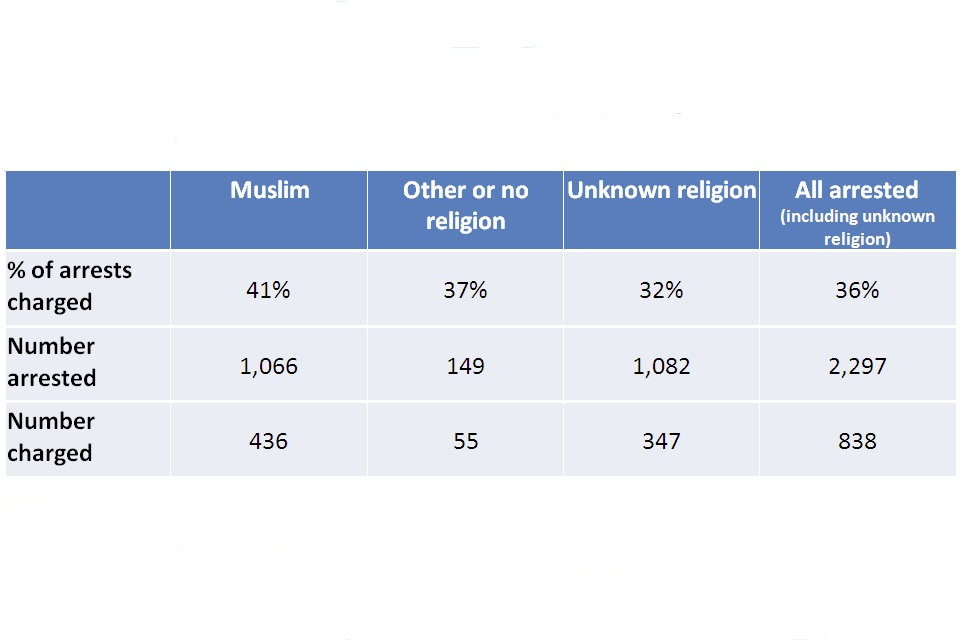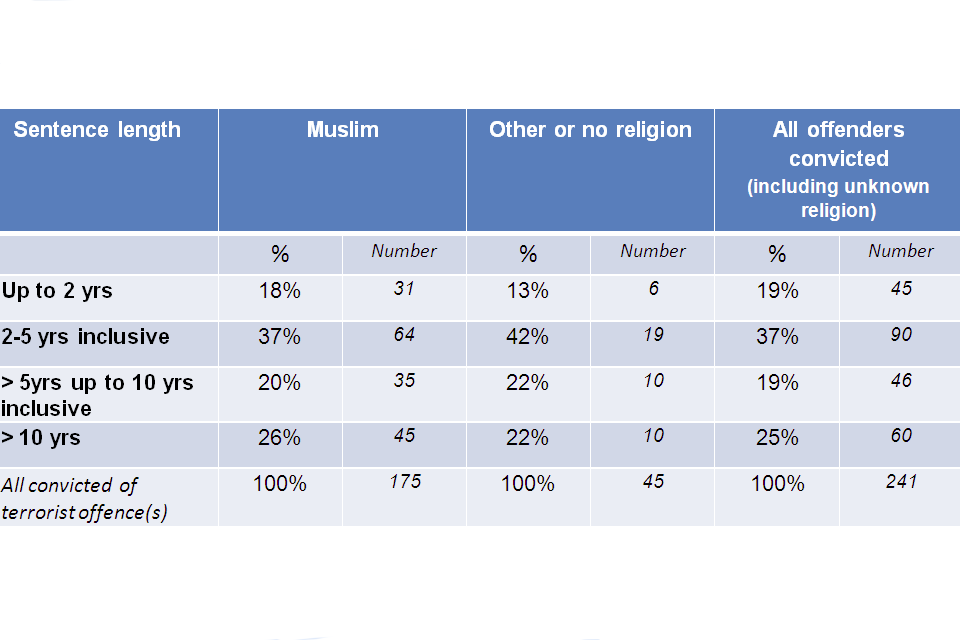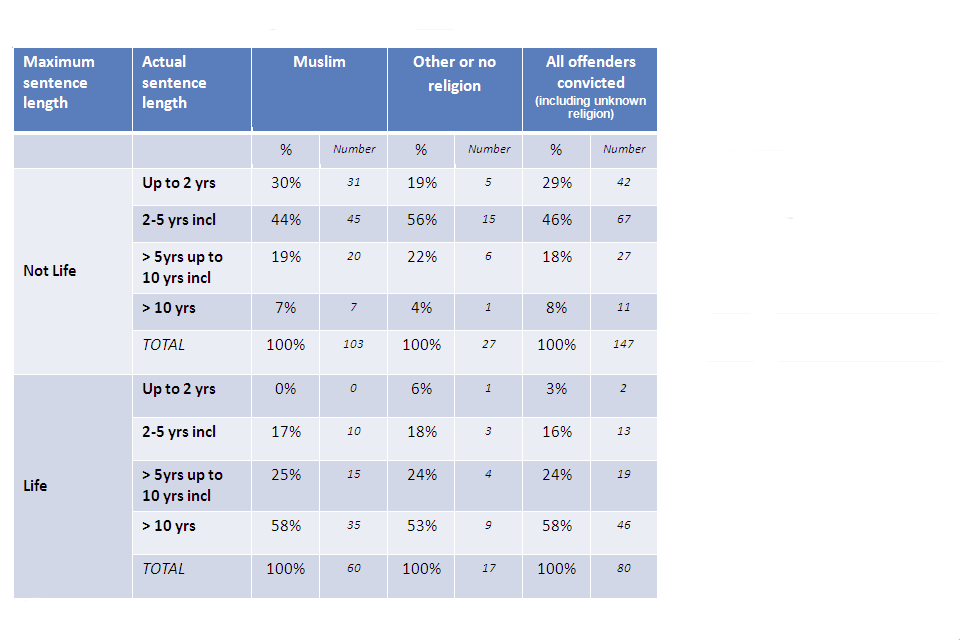Terrorism arrests - analysis of charging and sentencing outcomes by religion
Published 12 September 2013
1. Introduction
This briefing has been published alongside the 2012 to 2013 statistics on Operation of Police Powers under the Terrorism Act 2000 and subsequent legislation, to provide more detailed information. The short article is intended as additional analysis following a comment in the 2011 annual report by the Independent Reviewer of Terrorism Legislation, David Anderson Q.C., identifying a perceived link between religion and sentence length for those arrested for terrorism-related offences: “Some Muslims believe that there is a greater readiness on the part of press, politicians, police and law enforcement officers to characterise attacks by Muslims as ‘terrorism’ than attacks by far-right extremists. This, they say, results in discriminatory sentencing and cements popular perceptions of terrorism, at least in Great Britain, as crime perpetrated overwhelmingly by Muslims.” (The Terrorism Acts in 2011), David Anderson Q.C., June 2012, p.26).
The figures in this article are for people arrested, charged and/or convicted following a terrorism-related arrest in Great Britain, from September 2001 to the end of August 2012. An arrest is considered to be terrorism-related when, at the time of arrest or during the course of the subsequent investigation, a police officer suspects a person of being involved with terrorism (see the User Guide for more details). Figure 1.1 shows a flow chart of the Criminal Justice System following terrorism-related arrest. The analysis explores religious differences in charging outcomes (Box 1), sentencing outcomes (Box 2) and seriousness of offence (based on the maximum sentence available for the primary offence).
Chart 1.1: Flow chart of the Criminal Justice System

Data were obtained from the Association of Chief Police Officers’ Counter Terrorism Coordination Centre (ACTCC) and the National Offender Management Service (NOMS) and cover the period from September 2001 to the end of August 2012. The religion data from ACTCC and from NOMS are self- reported and there is no legal obligation for those arrested, charged or convicted to declare their religion. Religion data from ACTCC were used for the charging analysis (reported in section 3); however, for a large proportion of cases (47%), religion data were not available. For the sentencing analysis (reported in section 4), religion data from NOMS were used in order to increase the amount of data that could be included. Maximum possible sentence length for the primary offence was used as a measure of seriousness of the offence and was collated from the Ministry of Justice (MOJ) and ACTCC. Please refer to section 6 for further information about the data used.
2. Summary
The data on charges and convictions following terrorism-related arrest show that, statistically, there are no significant differences in the proportions charged, sentence length, or seriousness of offence between Muslim offenders and offenders of other or no religion.
The analysis is limited in that religion data are self-reported and are incomplete. It should also be borne in mind that there are other factors at play that can not be accounted for in the analysis and previous research shows that sentence length can be dependent on factors such as the presence of mitigating or aggravating factors; whether a defendant pleads guilty; or whether the defendant was represented or not.
3. Charges following terrorism-related arrest by religion (September 2001 to August 2012)
Between September 2001 and the end of August 2012, 2,297 people were subject to terrorism-related arrest in Great Britain. Of these, 838 were charged with either a terrorism-related or a non-terrorism-related offence.
Table 3.1 shows that 41% of Muslims arrested were charged with an offence, in comparison with 37% of those arrested with other or no religion. These proportions (41% compared to 37%) are not statistically significantly different. A statistical difference was found between the proportion of Muslims charged (41%) and the proportion of those with unknown religion that were charged (32%) following terrorism-related arrest.
Table 3.1: Proportion of terrorism-related arrests subsequently charged by religion (September 2001 to August 2012)

Table notes
Primary Source: ACTCC data on religion, arrests and charges between September 2001 and end of August 2012. Charges may be for terrorism-related offences or other offences.
Of the 838 charges following terrorism-related arrests, there were 491 cases in which religion data from the ACTCC were available. Table 3.2 compares the type of charge following a terrorism-related arrest by religion. Of those charged following a terrorism-related arrest, 67% of Muslims were charged with a terrorism-related offence compared to 75% of those arrested with other or no religion. This difference is not statistically significant so any apparent difference may well be explained by chance.
Table 3.2: Proportions of terrorism-related and other charges following terrorism-related arrest by religion (September 2001 to August 2012)

Table notes
Primary Source: ACTCC data on religion, arrests and charges between September 2001 and end of August 2012. Percentages may not sum to 100% due to rounding.
4. Sentencing outcomes following terrorism-related charge by religion (September 2001 to August 2012)
As noted earlier, religion data from NOMS were used in order to increase the amount of data that could be included for the sentencing analysis. Table 4.1 compares sentence lengths by religion. There are broadly similar proportions of Muslim offenders and offenders with other or no religion in each sentence length group. Where differences are apparent, they are not statistically significant. For example, 26% of Muslim offenders received sentences of more than 10 years, in line with 22% of offenders with other or no religion who received sentences of more than 10 years.
Table 4.1 Length of sentence (grouped) for convictions following terrorism-related charge (September 2001 to August 2012)

Table notes
Caution should be used in interpreting groups with small base sizes. Sources: sentence data from ACTCC; religion data from NOMS. Data period: September 2001 to end August 2012. Figures relate to those convicted of terrorism-related offences only. Figures exclude cases where sentence length was not available. Percentages may not sum to 100% due to rounding.
Chart 4.2 shows the average sentence lengths for different religious groups along with the upper and lower statistical bounds (confidence intervals at the 95% level). Overlaps of the bounds show where figures are not significantly different – any apparent differences are no greater than would be expected by chance. While the average sentence length of those identified as Muslim (8.3 years) is higher than those with other or no religion (6.9 years), the difference is not statistically significant.
The analysis is limited as average sentence length is influenced by the contributions made by a few longer sentences. There are other factors that could influence sentence length and have not been controlled for in the analysis. Previous research, ‘Statistics on Race and the Criminal Justice System 2010’, shows that sentence length can be dependent on factors such as: the seriousness of offence; the presence of mitigating or aggravating factors; whether a defendant pleads guilty; or whether the defendant was represented or not. The analysis in the next section, that looks at seriousness of offence, demonstrates this point very clearly.
Chart 4.2: Average sentence length (years) by religion for convictions following terrorism-related charge (September 2001 to August 2012)

Chart notes
Caution should be used in interpreting groups with small base sizes. Sources: sentence data from ACTCC; religion data from NOMS. Data period: September 2001 - end August 2012. Figures relate to those convicted of terrorism-related offences only. Average scores were calculated from all terrorism-related convictions where a sentence length was provided. Base sizes for each of the religious groups are as follows: Muslim 175; Other or no religion 45; Unknown religion 21. Figures exclude cases where sentence length was not available.
5. Seriousness of offence and sentencing outcomes following terrorism-related charge by religion (September 2001 to August 2012)
The analysis also explored the sentencing outcomes by seriousness of offence and religion. Maximum sentence length for the primary offence was used as a measure of seriousness of the offence. The distributions of sentence length for each religion group (as shown in Table 5.1) were compared for maximum sentences of ‘life’ and ‘not life’. The importance of exploring sentencing patterns according to this breakdown is illustrated well by the figures in Table 5.1. The figures show very different sentencing for those cases where the maximum sentence available was ‘life’ as opposed to ‘not life’, with overall percentages in these 2 categories being sentenced to more than 10 years being 58% and 8% respectively.
Table 5.1 shows that the profile of actual sentence lengths within each of these categories appears broadly similar for Muslim offenders and offenders with other or no religion. For example, of offences potentially carrying a life sentence, 58% of Muslim offenders received sentences of more than 10 years, in line with 53% of offenders with other or no religion. No statistically significant differences were found (although there were some small base sizes in this analysis which means it is more difficult to identify a statistically significant difference).
Table 5.1: Sentence length (years) following terrorism-related charge by religion and within maximum sentence categories (September 2001 to August 2012)

Table notes
Caution should be used in interpreting groups with small base sizes. Sources: Maximum sentence length information collated from MOJ and ACTCC; actual sentence length from ACTCC; religion data from NOMS. Data period: September 2001 to end August 2012. Figures relate to those convicted of terrorism-related offences only. Percentages may not sum to 100% due to rounding. Figures exclude cases where maximum sentence length data were not available. Maximum possible sentence information is based on the primary offence only. (Actual) sentence length is the total sentence given, which may relate to other offences in addition to the primary offence.
6. About the figures
The figures are ‘Official Statistics’ and are drawn from administrative systems and have not necessarily been subject to the same detailed verification processes as those badged as National Statistics. Overall, the data quality for this short article is considered to be sufficient for publication but the data are not designated as National Statistics. The data are administrative counts of the number of arrests, charges and convictions following terrorism-related arrest as recorded by ACTCC and NOMS.
Self-reported religion data from ACTCC were used for the charging analysis (reported in section 3). In a large proportion of cases (47%), religion data were not available: in 1,082 cases religion data were missing (out of 2,297 arrests). Of the 838 individuals who were charged, there were 491 cases where religion data from ACTCC were also available.
For the sentencing analysis (reported in section 4), self-reported religion data from NOMS were used in order to increase the amount of data that could be included. NOMS data, collected on entry to prison, are only available for people that have been convicted of an offence. Of the 289 cases in the dataset, NOMS religion data and ‘actual’ sentence information were available in 241 cases; and NOMS religion data, ‘actual’ sentence information and maximum sentence information was available in 227 cases.
The maximum possible sentence length for the primary offence was used as a measure of seriousness of the offence. The maximum sentence length was taken as the Crown Court maximum sentence length for each offence. In some instances the sentence length may not solely relate to the primary offence but may be the total of consecutive sentencing. No information on other offences committed or consecutive sentencing was readily available to us within the time constraints of this work. Maximum sentence information was sourced from a compendium of offences compiled by the MOJ and from advice from ACTCC.
The data collection was designed for management information purposes, and not for the purposes of research so may be limited in terms of completeness and accuracy. As such, the figures presented may be considered a sub-set, or sample, of the population of all terrorism-related arrests, charges and convictions. Any sample survey may produce estimates that differ from the figures that would have been obtained if the whole population had been observed. It is, however, possible to calculate a range of values around an estimate, known as the confidence interval (also referred to as margin of error) of the estimate. At the 95 per cent confidence level, over many repeats of a survey under the same conditions, one would expect that the confidence interval would contain the true population value 95 times out of 100. This can be thought of as a one in 20 chance that the true population value will fall outside the 95 per cent confidence interval calculated for the survey estimate.
Because of this variation, changes in estimates between population subgroups may occur by chance. In other words, the change may simply be due to which people were randomly selected or how they were randomly allocated throughout the criminal justice system. We are able to measure whether this is likely to be the case using standard statistical tests and conclude whether differences are likely to be due to chance or represent a real difference. Only increases or decreases that are statistically significant at the five per cent level (and are therefore likely to be real) are described as statistical significant changes within the publication.
Statistical testing for independence between the religious groups has been carried out on all the stated comparisons. Differences in proportions have been tested using a Pearson chi-square test with a p-value of 0.05. Z-test of proportions was used to test for significant differences in the proportions charged following arrest by religious group. Independent t-tests were used to compare the mean sentence lengths between religious groups. These tests show that the comparisons are not statistically significant, unless otherwise stated.
Over the period of study there have been a number of changes to terrorism legislation and sentencing practices. Information on the development and use of sentencing guidelines, including existing research and analysis, is published by the Sentencing Council. The Terrorism Act 2000 is the UK’s core piece of counter-terrorism legislation. Developed over a number of years it establishes a permanent body of law designed to tackle both domestic and international terrorism. The Act has frequently been amended and supplemented by further legislation in response to the shift from domestic to international terrorism, changes in the extent and nature of the threats faced, developments in technology and a number of legal judgments. Details of the legislation is available at legislation.gov.uk.
The key pieces of counter-terrorism legislation that have been passed since 2001 are:
- Anti-Terrorism, Crime and Security Act 2001;
- Prevention of Terrorism Act 2005;
- Counter-Terrorism Act 2008;
- Terrorist Asset-Freezing Act 2010;
- Terrorism Prevention and Investigation Measures Act 2011; and
- Protection of Freedoms Act 2012
